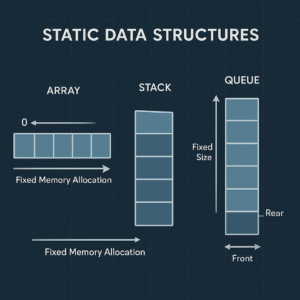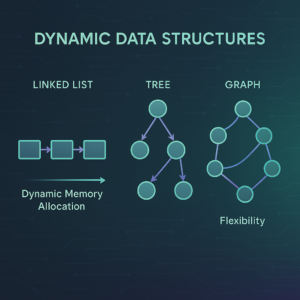Static Data Structures
Overview of Static Data Structures

Static data structures are fixed-size data structures that allocate a predetermined amount of memory at compile time. These structures do not allow for resizing; once created, their size remains constant. This characteristic makes them efficient in terms of memory usage, as they avoid the overhead associated with dynamic memory allocation.
Common examples of static data structures include arrays and structures in programming languages. Their predictability in size aids in simplifying memory management and enhancing performance, especially in systems with stringent resource requirements.
Characteristics
Characteristics of Static Data Structures
Static data structures are defined by their fixed size and structure at compile time. Once created, the size of these structures cannot be altered during program execution.
Memory Allocation
Memory allocation for static data structures occurs at compile time, which leads to predictable memory usage and potentially faster access times.
Efficiency
Static data structures typically allow for efficient data access and manipulation, as they enable direct indexing without the overhead of dynamic memory management.
Examples
Examples of Static Data Structures
Static data structures are those whose size is fixed at compile time, meaning the amount of memory allocated is determined during the program’s execution. This immutability results in efficient memory usage and predictable access times.
Arrays
Arrays are one of the most common examples of static data structures. They hold a fixed number of elements of the same type and allow indexed access to their elements, making data retrieval fast.
Structures (Structs)
Structures group different types of data under a single name, allowing users to create complex data models while maintaining a static size that can be defined at compile time.
Dynamic Data Structures
Overview of Dynamic Data Structures

Dynamic data structures are data structures that can grow and shrink in size during the execution of a program. Unlike static data structures, which have a fixed size determined at compile time, dynamic structures allow for more flexible memory management.
They are essential for applications that require frequent modifications to data, such as insertion or deletion of elements. Common examples include linked lists, stacks, and queues. These structures utilize dynamic memory allocation, enabling efficient use of system resources.
Characteristics
Characteristics of Dynamic Data Structures
They can grow and shrink
Unlike static data structures, they can grow or shrink in size during runtime. This adaptability allows efficient use of memory, responding to changing data requirements.
Use of pointers
One key characteristic is that dynamic structures use pointers to link elements, enabling non-contiguous memory allocation. This connection allows for efficient insertions and deletions, showcasing the resilience and versatility of dynamic structures in various applications.
Examples
Examples of Dynamic Data Structures
Dynamic data structures allow for flexible memory usage and can grow or shrink as needed during program execution. This adaptability makes them suitable for applications where data size cannot be predetermined.
Linked Lists
Linked lists consist of nodes that contain data and pointers to the next node. They enable efficient insertions and deletions without reallocation or reorganization of the entire structure.
Dynamic Arrays
Dynamic arrays, unlike static arrays, can resize themselves automatically when more space is needed, providing a balance between performance and flexibility.
Trees
Trees, especially binary trees, are hierarchical structures that can expand as new nodes are added, making them optimal for various applications such as databases and file systems.
Comparison
Quick Comparison Table
| Feature | Static | Dynamic |
|---|---|---|
| Size | Fixed | Flexible (can grow/shrink) |
| Memory Allocation | At compile time | At runtime |
| Speed | Generally faster access | Can be slower due to pointer use |
| Flexibility | Low | High |
| Examples | Array, fixed queue | Linked list, tree, dynamic queue |